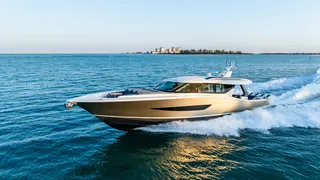Scout Boats’ muscular new flagship is the end result of an intriguing collaboration with an acclaimed superyacht designer. Cecile Gauert steps on board to discover the behind-the-scenes story...
From the first rumours of the 670 LXS, I was intrigued. This project far exceeds anything South Carolina’s Scout Boats had built before, and it involved acclaimed superyacht designer Harrison Eidsgaard.
At 20.42 metres, this is Scout’s answer to its clients’ desire for bigger boats. It goes well beyond the notion of the traditional centre console – it is a bold crossover of American muscle, with five Mercury 600 V12s and yacht sensibilities.
Scout’s designer knew about Harrison Eidsgaard from a stint at Heesen Yachts, and they were approached to add that superyacht touch. “When I looked at their website for the first time, I thought the beautifully flared hull was stunning and I knew we could do something special,” Peder Eidsgaard said.
Fitting everything in with style fell in part to Harrison Eidsgaard’s project manager, Jesse Huijser, who worked closely with the Scout team, including Stevie Potts, Steve’s son, and senior designer Jeff Summers. “We pushed to optimise the ergonomics with the help of 3D modelling,” Huijser said. “I think it’s been a good result.”
Harrison Eidsgaard worked on refinements above the waterline. “Simplicity is everything on a boat like this,” Eidsgaard said. “We emphasised the sheer line and added a simple, dark hull window band with a small kink at the back that’s repeated in the structure and the windows,” he added. “You also have the fact that (such a boat) needs to look very dynamic and fast, so those two things are what the exterior is all about.”
The slickness outside leaves you unprepared for the generous space on board. “Once you’re in the lower deck, you have the windshield and the skylight above you, and you get such a feeling of space,” Huijser pointed out.
On board Everest, the first Scout 670 LXS, I try out different spots – the forward lounge’s sunbed, the companion seats at the helm, a bar stool and the bench seat aft. There are 11 of us and we easily find spaces to settle – a great feature on a boat that is on the narrow side at 4.93 metres.
The interior is not just luxurious, it’s also highly functional. The lower deck offers space for a lounge area and three cabins. However, knowing this might be used more as a dayboat, the designers gave the forward main cabin a central door, which, when left open makes it feel like more integral part of the deck and increases the feeling of space. “Yes, you can take this to the Bahamas for a weekend, but maybe you end up staying at a hotel,” Eidsgaard said.
Practical touches are numerous, with storage hidden everywhere. Up one level is a galley that serves an indoor/outdoor bar and dinette. The rear glass door and window open, so in fine weather you have a large area for activities. Folding stairs ease access and stow out of the way, while side platforms expand the cockpit.
For decor and finishes, Freya Hiscock, Harrison Eidsgaard’s interior designer, created three distinct schemes: Salt, Coral and Neptune.
“From the outset, material selection was guided by the yacht’s performance-driven lifestyle where interiors must withstand indoor-outdoor living, exposure to salt air and sunlight, and the demands of high-speed cruising,” she explained.
Everest follows the Salt scheme, which blends light oak walls and dolphin-grey upholstery, and a more nautical feel outside with touches of blue. The outdoor fabrics can handle everything from wet clothes to spilled drinks and fishy residue, because this mini yacht can fish, with multiple rod holders, fish tanks and bait wells.
As for performance, Captain Casey added: “In the ocean, we’ve seen between 48 and 50 knots, and inland we can get 52.” He’s thoroughly tested its seakeeping abilities on the ride down from South Carolina to Palm Beach.
The 670 LXS’s helm station features 24-inch Garmin displays, Mercury controls, Zipwake dynamic trim control and an advanced vessel-management system.
“You can control everything from the Garmin,” he said. “Once you’re under way, (the boat) is so well balanced you barely need to touch the wheel,” the captain continued. “With the joystick, you can press ‘heading hold’ and it will keep pointing in a straight line, and you can make little changes, you can tap it or twist it (to correct and adjust heading).”
The advent of Mercury 600s allowed this boat to happen. Scout always wanted outboards that deliver speed, the ability to gather at a sandbar in centimetres of water and the range you need to get there and back safely.
“Your fuel economy is not going to change too much at cruising speeds, any of the normal 26, 39 even 43 knots is going to be in the same (consumption) range until you reach that last little bit,” said Captain Casey. “The maximum range would be 330 to 350 nautical miles.”
The goal was to reach more than 400 nautical miles, and this prototype came out a little heavier than optimal, Summers said, “although it exceeded expectations,” but a few changes to the Seakeeper gyrostabilisers and generators will correct this on future hulls.
So to sum it up, it’s quite a full package and a bundle of fun to drive. It also was a great design project. “This was not about commercial gain,” said Eidsgaard. “We love designing boats, whether they’re 20 metres or 120. That passion makes it easier to collaborate and dream up what comes next.”
Scout 670 LXS specs
Model: Scout 670 LXS series
LOA: 20.35m
Beam: 4.93m
Draught: 1.04m
Displacement: 34,000kg (loaded)
Engines: 5 x Mercury V12 600hp
Speed (top/cruise): 52/30-35 knots
Range: Up to 400nm
Price: From $5.9 million
First published in the October 2025 issue of BOAT International. Get this magazine sent straight to your door, or subscribe and never miss an issue.

